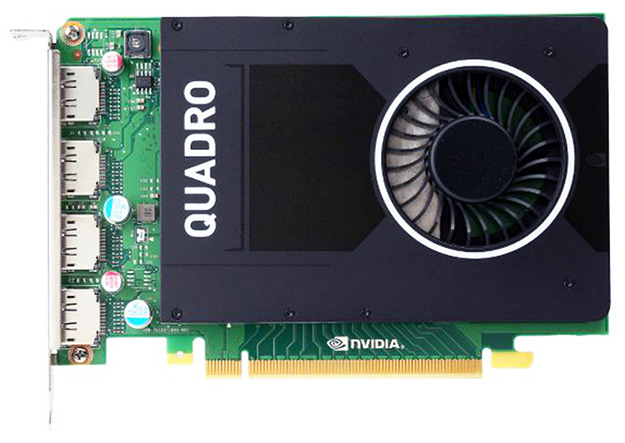NVIDIA Quadro M2000 Review: Affordable Maxwell Pro Graphics
The Quadro M2000’s main features and specifications are listed in the table below. We’ll follow those up with a quick tour of the hardware and then move on to some pro-graphics benchmarks to round out the story...
|
| GPU Memory | 4 GB GDDR5 |
| Memory Interface | 128-bit |
| Memory Bandwidth | Up to 106 GB/s |
| CUDA Cores | 768 |
| System Interface | PCI Express 3.0 x16 |
| Max Power | 75W |
| Thermal Solution | Active |
| Form Factor | 4.376” H x 6.6 L |
| Display Connectors | DP 1.2 (4), with audio |
| Max Displays | 4 DP 1.2 Multi-Stream |
| Max DP 1.2 Resolution | 4096 x 2160 @ 60Hz |
| Graphics APIs | DirectX 12, OpenGL 4.5, Shader Model 5.0, Vulkan 1.03 |
| Compute APIs | CUDA, DirectCompute, OpenCL |
| Additional Features | NVIDIA nView Desktop, Management Software Compatibility, HDCP Support, NVIDIA Mosaic |
| Pricing: | Estimated Street $450 |
If you follow the graphics space, the specifications above will give you a good sense of the Quadro M2000's capabilities and where it lands in NVIDIA's product stack. The card has 768 CUDA cores and 4GB of GDDR5 memory, linked to the GPU via a 128-bit interface. If some of those specs sound familiar, it's because they're similar to the GeForce GTX 950. Both the Quadro M2000 and the GTX 950 are built around the GM206 GPU, though the Quadro has a few more tricks up its sleeve.
The Quadro M2000's GPU has a peak boost frequency of 1,108MHz and its memory has an effective clock speed of 3,305MHz, which translates to roughly 106GB/s of peak memory bandwidth. The TDP on the card is only 75 watts, which is low enough to eliminate the need for a supplemental power connector, and cooling is handled by a relatively slim, low-profile heatsink and fan assembly. In fact, the card requires only a single PCIe x16 slot -- the cooler doesn't encroach on the adjacent slot like most consumer-class graphics card.
The backside of the Quadro M2000's PCB is relatively bare. A couple of its memory chips are visible, along with some surface mounted caps and resistors, but that's about it. There are no power connectors or SLI connectors to speak of.
Outputs on the Quadro M2000 consist of a quartet of DisplayPort 1.2 multi-stream outputs, that all support true 4K 4096 x 2160 resolutions at 60Hz, with audio.









